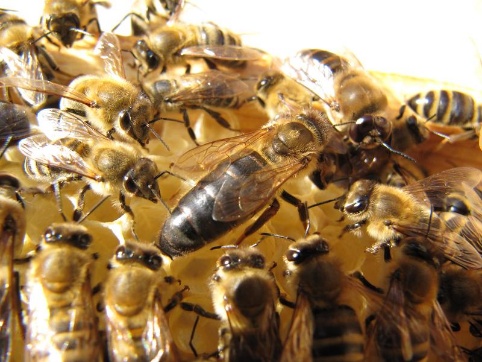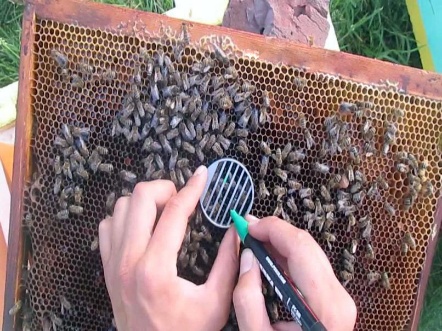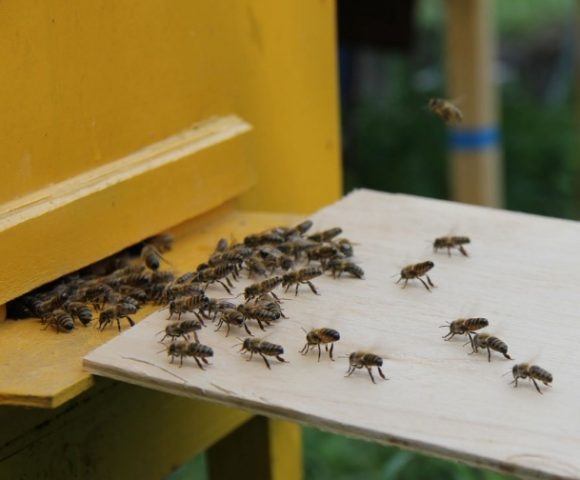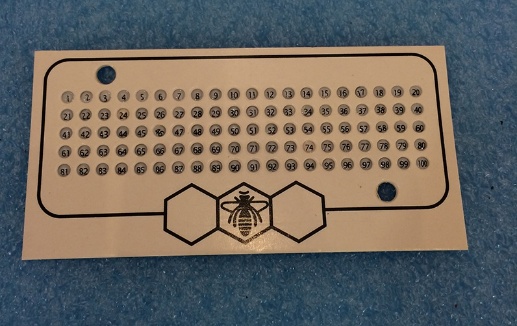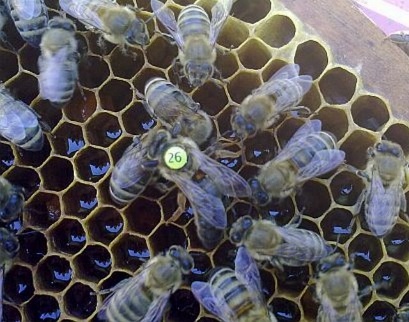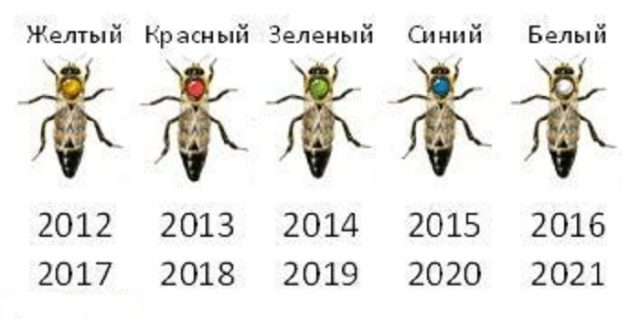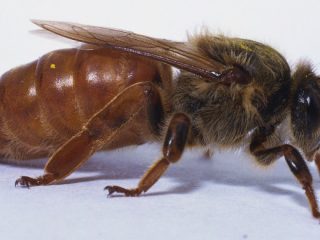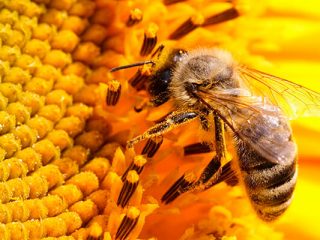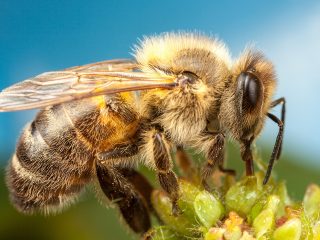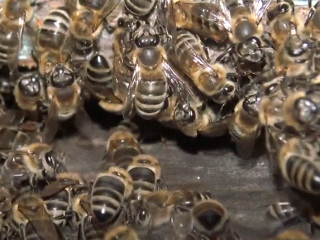Content
The queen marker is one of the most important in beekeeping after the framed hive. You can do without a smoker, many even flaunt this fact. You can skip using a honey extractor and sell honey in combs. But every bee family must have a fertile queen. And the beekeeper should know when it is time to replace this female with a new one. And here you cannot do without a label on the queen bees.
The simplest device for a mark is very similar in shape and essence to a regular marker, but it does not contain alcohol paint, but a special varnish. There are also opalite tags with numbers that are more difficult to use. They already require their own "accompanying equipment", but such tags are more resistant. But everywhere and always in order to mark the queen bee, she must be found.
How to identify a uterus in a hive
A fertile female differs from ordinary bees in the length of the abdomen and the width of the breast. She also has differences in color, but this difference is so small that it will hardly be possible to catch her at first glance. And you need to find the uterus quickly, as she tries to hide and constantly moves to a secluded place.
Workers cover the queen. It is necessary to search for it where there are most of the bees. The abdomen of the female often sticks out from under the accumulation of bodies of worker bees. The second option, which is also striking: a large and shiny breast spot. The dorsum of the female is smooth and black, since it is not covered with hairs, as in worker bees. This difference is clearly visible against the general background of "fluffy" insects. The queen is too large for the bees to hide completely. The abdomen or breast will surely "give out" the queen bee.
How to determine the presence of a uterus in a hive
There is no need to search for queens at each examination. This is a gross interference in the life of the colony. There are signs of a healthy family, which, even without a thorough examination, will indicate the usefulness of the swarm. There are also signs that the bees are left without a queen.
The presence of a high-quality fertile female is determined by the brood. If there is a one-day clutch of eggs or an unsealed brood in the hive, the queen is present and working.
But you need to take a closer look at the laid eggs. If there is no queen in the hive, a tinder bee can take over its functions. In this case, the seeding with eggs will be uneven. The tinder skips the cells and lays 2-3 eggs in one.
It is impossible to visually distinguish the tinderpot from the workers. But sometimes an old or diseased uterus is also unable to work. Such a female must be found and replaced with a new one.
How to find a uterus in a swarm
There are also some secrets on how to quickly find the queen in the hive:
- do not rely on the surviving mark;
- do not abuse the smoker, the swarm will begin to hide the queen bee;
- find frames with the most bees;
- pay attention to the behavior of insects, the bees are calmer near the queen, several of them are always with their heads towards the queen;
- after removing one of the frames, immediately look at the next one remaining in the hive, the uterus may be there;
- on the removed frame, first of all, to inspect the side that was in the shade, the uterus tend to hide in a dark place;
- you need to start examining the frame from the edges, if the uterus was closer to the edge, it can escape to the opposite side of the honeycomb;
- special attention should be paid to a ball of bees, workers hide the queen, covering her with their bodies.Important! It is enough to blow on such an accumulation so that the insects crawl to the sides and open the uterus, if there is one;
- the best option: two people search for the uterus, so you can simultaneously check both sides of the frame at once.
Before starting the search for the uterus, the extreme frames in the hive are taken out and set aside. There are usually no females on them, and there are few workers. Removing the extreme frames will make it possible to rearrange the already examined honeycombs slightly to the side, so that the uterus does not crawl onto them again.
There is an easier way that does not require special attention and does not take much time. To locate the queen, you will need a metal mesh frame that completely covers the hive. The size of the longitudinal holes in the mesh is 4.5 mm. You can find a suitable mesh yourself or buy it from a specialized store.
All bees are shaken off to one half of the hive, and a frame with a net is placed in the middle. Then the swarm is distilled from one half to the other. Smaller workers will pass through the net, while larger drones and queen bees will remain in the first half of the hive.
The third method is quite laborious and risky, but does not require special devices:
- in the evening in warm dry weather they wait for the bees to return home;
- a sheet is spread in front of the hive;
- all the bees from the frames are gently shaken off onto it;
- they kneel down without sudden movements and carefully examine the bees crawling on the sheet;
- finding the uterus, it is carefully covered with a special cap and placed in a cage;
- the sheet is moved closer to the hive and a board is placed against the tap hole;
- after the bees have returned home, you can take care of the queen.
Most often, this method is used when you need to replace the queen. In this case, the new female is not planted immediately, but only in the morning. This is how a colony that feels orphaned will better accept the new uterus. If you just need to put a mark, the uterus is marked and placed back in the hive.
If you don't grab it right away, it can take off. Mostly unfertilized uterus take off. Perhaps it makes sense to replace the "flying" queen.
How to tell if a hive has a queen without opening the hive
In the summer, when the colonies are working at full strength, experienced beekeepers do not recommend disturbing the bees once again. But at the same time, it is necessary to control the presence of a uterus in the family for the colony to flourish. It is possible, without opening the hive and without disturbing the insects, to determine whether the bees have a queen. There are some signs of the absence of a uterus in the hive:
- A family without a queen makes a special buzz. This is not the "cry" of a colony that has just lost a female. The sound is different.
- The hive is worn out because the insects are agitated and consume too much food.
- Workers do not carry the polish necessary for feeding the larvae into the hive.
- Bees are "lazy", reluctant to fly, take off only after jogging to the edge of the landing board.
- Workers take off and return immediately.
- Bees from an orphaned family are characterized by the behavior of "begging" to their own hive.
Bees caught in bad weather often have to ask for someone else's hive to wait out the bad weather. Only "loaded" individuals are allowed into someone else's family. An "empty" bee has to beg for permission to enter for a long time, lifting its abdomen up and quickly flapping its wings. But in a queenless colony, this behavior is demonstrated by family members.
Owners of small apiaries can determine the absence of a queen in a family by observing the behavior of insects. On large industrial apiaries, it is easier to put a mark and then look for queens visually.
How to check for the presence of a queen if there is no brood
The situation when there is absolutely no brood in the hive, neither fresh nor sealed, does not mean that there is no queen, and a new one must be urgently introduced. The uterus in the colony may be present, but not working. The reasons why the uterus does not sow eggs are different:
- inability to fly due to congenital deformity after the varroa mite;
- bad weather during the flyby;
- absence of nearby drones from other apiaries;
- any disease.
If there is a queen bee in the hive, you cannot put another one there. The bees will kill the stranger. Visually, it is also not always possible to find a female, especially if she is still not there.
First you need to make sure that the uterus is really missing. This is done using a brood control frame.
A frame with an open brood is placed in the hive and the date is signed. Wait 2 days. If there is no queen in the colony, the bees will start building fistula queen cells. If there is a female, the workers will simply seal the brood.
In the absence of queen cells, you will have to look for a female. This individual will need to be removed and a new fetal uterus placed in the colony.
Why do you need to mark queens
An amateur beekeeper with a small apiary can afford to rely on memory or records and change queens as needed. But it is much more convenient to mark the queen bees. Bright spots allow you to quickly find the female among the workers. And with a large apiary, they also facilitate control over the age of the queen bees. When breeding brood queens for sale, tags help to trace the pedigree of the future queen of the swarm. Placing a tag is not a very time-consuming operation, which greatly simplifies the life of the beekeeper in the future.
How can you mark the bee's queen
For bees, use the same remedies as for other insects:
- paint;
- varnish;
- opalite tags;
- homemade compositions.
The main requirement for all labels is bright colors, so that the queen immediately "catches the eye". Sometimes experienced beekeepers mark queens by cutting their wings.
Paints have certain disadvantages. Workers are hardworking creatures. They constantly cleanse not only themselves of pollen and dirt, but also their queen. Because of this, the paint is quickly erased. That is why when looking for a queen in a hive, you should not count on a mark, especially after wintering. Another disadvantage of the paint mark: you cannot put either a year or a number on it.
Opalite tags are the most durable, but require additional equipment:
- BF-6 glue or Shellac alcohol solution;
- a spatula for applying glue or, at least, a toothpick;
- match or the same spatula for applying the mark to the glue.
The opalite markers are light, but hard and large enough to prevent the female from checking the cells. Another disadvantage of the opalite mark is that it must be glued very carefully. The label is glued exactly in the middle of the upper chest or closer to the back end.
Sometimes ordinary nail polish is used, but such a marker is undesirable for queens, there are too many harmful substances in it. Also, do not use celluloid and acetone paint dissolved in acetone. Acetone, found in all "folk" labeling products, is capable of damaging chitin.
Colored labels for queens by year
An amateur beekeeper who is engaged in breeding females for sale does not care how to mark the queens. The main thing for him is not to get confused in the system of labels. In an industrial apiary or pedigree beekeeping, it is best to stick to the international tagging system. In this system, 5 colors are used to mark queens by year. The five-year cycle is developed because during breeding for more than 5 years, the female is not kept and replaced with a new one. Colors of queen tags by year:
- yellow – 2012/2017/2022;
- red – 2013/2018/2023;
- green – 2014/2019/2024;
- blue – 2015/2020/2025;
- white – 2016/2021/2026.
To calculate what color of the mark will be in the future, it is enough to add five years.
Tagging queen bees by cutting wings
Quite a complex method used by experienced beekeepers. Some people consider this method to be optimal, since there is no danger that glue or paint will spread all over the chest and flow onto the head.
In this method, the female is held by the breast with the thumb and forefinger of the left hand. The insect's wings are free. Manicure scissors make marks, figuratively cutting off the wings. How to mark the uterus in this case is decided by the beekeeper himself.
Opponents of wing cutting have reasons for negative attitudes. If the female bee really didn’t need wings after the flight, she would lose them when she returned to the hive. Keeping your wings alive is a waste of energy. Ant females chew off their wings immediately after fertilization. If the bee queens do not lose their wings, then they are needed.
The second drawback of the method: the limited number of options for tags and the danger of crushing the insect too hard.
Queen markers
Inexperienced beekeepers are better off using bee markers. When using these markers, you do not need to press down on the insect. Simply place the marker rod on the dorsum of the uterus. For serious work in the apiary, it is better to stock up on markers of all 5 colors.
The queen bee does not even need to be picked up in order to put a mark on it with a marker. There is a special device to immobilize the female.
Other methods and devices for tagging queens
In principle, there are no other devices for bee marks. The only difference is the dyes with which the labels are put:
- stationery proofreader;
- nail polish;
- fluorescent varnish.
Here the role is played exclusively by the desire to save money. Special markers are significantly more expensive than office supplies and cosmetics.
Additional non-standard equipment can be attributed only to the holder for the frame, which is shown by the author of the video:
Opalite tags are made from lightweight plastic or foil. They are industrially marked with numbers from 1 to 100. But due to the high cost and complexity of use in amateur beekeeping, these marks are rarely used.
How to tell if there is no queen in the hive
The situation when there is no one to mark in the hive does not happen so rarely. It can be difficult for beginners to determine if a colony has a uterus. Because of such errors, the colony has time to die before the beekeeper understands what the matter is.
If there is no queen bee in the hive, the nurse bees also begin to bring honey, becoming foragers. A large amount of honey may even please a beginner. But working individuals gradually die of old age, and they are not replaced by young ones. As a result, the colony is gradually dying out.
How bees behave without a queen
Without a queen bee, bees deteriorate in character. They become lazy and moody. They react to the opening of the hive with a specific buzzing. Often, workers build queen cells that remain empty. The amount of honey increases, but the foragers stop bringing pollen to the hive.
Quite often you can observe a specific small tremor of the wings. This tremor differs from the asking pose, which is also characteristic of individuals from an orphaned family.
What to do if the uterus in the hive is missing
The way in which orphaned families are corrected depends on the time of year when the colony lost its female. If this happened in winter or early spring, a fertile female from another family is planted in the hive.
If it turns out that the bees do not have a queen in July, and honey collection in the region stops at the beginning of August, there is no need to rush to correct it. Foragers will apply more honey. But in August, you need to place an open brood in the hive so that the family does not turn away.
Correction of a queenless family in the fall is easiest. For this, two families are united: queenless and full-fledged.
Conclusion
The device for the uterus mark, for all its simplicity, is necessary for serious business management.It does not harm the bees, but it helps the beekeeper navigate the timing of replacing old females.

